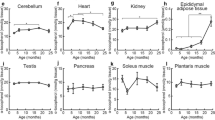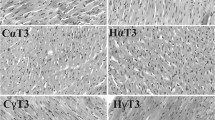Abstract
From an enzyme kinetic study using rat liver microsomes, α-tocopherol has been suggested to accelerate the other vitamin E catabolism by stimulating vitamin E ω-hydroxylation, the late limiting reaction of the vitamin E catabolic pathway. To test the effect of α-tocopherol on catabolism of the other vitamin E isoforms in vivo, we determined whether α-tocopherol accelerates depletion of γ-tocopherol and tocotrienol and excretion of their metabolites in rats. Male Wistar rats were fed a γ-tocopherol-rich diet for 6 weeks followed by a γ-tocopherol-free diet with or without α-tocopherol for 7 days. Intake of γ-tocopherol-free diets lowered γ-tocopherol concentrations in serum, liver, adrenal gland, small intestine, and heart, but there was no effect of dietary α-tocopherol on γ-tocopherol concentrations. The level of urinary excretion of γ-tocopherol metabolite was not affected by dietary α-tocopherol. Next, the effect of α-tocopherol on tocotrienol depletion was examined using rats fed a tocotrienol-rich diet for 6 weeks. Subsequent intake of a tocotrienol-free diet with or without α-tocopherol for 7 days depleted concentrations of α- and γ-tocotrienol in serum and tissues, which was accompanied by a decrease in the excretion of γ-tocotrienol metabolite. However, neither the tocotrienol concentration nor γ-tocotrienol metabolite excretion was affected by dietary α-tocopherol. These data showed that dietary α-tocopherol did not accelerate the depletion of γ-tocopherol and tocotrienol and their metabolite excretions, suggesting that the positive effect of α-tocopherol on vitamin E ω-hydroxylase is not sufficient to affect the other isoform concentrations in tissues.





Similar content being viewed by others
Abbreviations
- CEHC:
-
Carboxyethyl-hydroxychroman
- α-CEHC:
-
2,5,7,8-tetramethyl-2(2′-carboxyethyl)-6-hydroxychroman
- γ-CEHC:
-
2,7,8-trimethyl-2(2′-carboxyethyl)-6-hydroxychroman
- CYP:
-
Cytochrome P450
- α-TTP:
-
α-tocopherol transfer protein
References
Schultz M, Leist M, Petrzika M, Gassmann B, Brigelius-Flohé R (1995) Novel urinary metabolite of α-tocopherol, 2,5,7,8-tetramethyl-2(2′-carboxyethyl)-6-hydroxychroman, as an indicator of an adequate vitamin E supply? Am J Clin Nutr 62:1527S–1534S
Swanson JE, Ben RN, Burton GW, Parker RS (1999) Urinary excretion of 2,7, 8-trimethyl-2-(β-carboxyethyl)-6-hydroxychroman is a major route of elimination of γ-tocopherol in humans. J Lipid Res 40:665–671
Lodge JK, Ridlington J, Leonard S, Vaule H, Traber MG (2001) α- and γ-tocotrienols are metabolized to carboxyethyl-hydroxychroman derivatives and excreted in human urine. Lipids 36:43–48
Sontag TJ, Parker RS (2002) Cytochrome P450 ω-hydroxylase pathway of tocopherol catabolism. Novel mechanism of regulation of vitamin E status. J Biol Chem 277:25290–25296
Bardowell SA, Duan F, Manor D, Swanson JE, Parker RS (2012) Disruption of mouse cytochrome p450 4f14 (cyp4f14 gene) causes severe perturbations in vitamin E metabolism. J Biol Chem 287:26077–26086
Parker RS, Sontag TJ, Swanson JE (2000) Cytochrome P4503A-dependent metabolism of tocopherols and inhibition by sesamin. Biochem Biophys Res Commun 277:531–534
You CS, Sontag TJ, Swanson JE, Parker RS (2005) Long-chain carboxychromanols are the major metabolites of tocopherols and tocotrienols in A549 lung epithelial cells but not HepG2 cells. J Nutr 135:227–232
Abe C, Uchida T, Ohta M, Ichikawa T, Yamashita K, Ikeda S (2007) Cytochrome P450-dependent metabolism of vitamin E isoforms is a critical determinant of their tissue concentrations in rats. Lipids 42:637–645
Ikeda S, Tohyama T, Yamashita K (2002) Dietary sesame seed and its lignans inhibit 2,7,8-trimethyl- 2(2′-carboxyethyl)-6-hydroxychroman excretion into urine of rats fed γ-tocopherol. J Nutr 132:961–966
Uchida T, Ichikawa T, Abe C, Yamashita K, Ikeda S (2007) Dietary sesame seed decreases urinary excretion of α- and γ-tocopherol metabolites in rats. J Nutr Sci Vitaminol 53:372–376
Cooney RV, Custer LJ, Okinaka L, Franke AA (2001) Effects of dietary sesame seeds on plasma tocopherol levels. Nutr Cancer 39:66–71
Lemcke-Norojärvi M, Kamal-Eldin A, Appelqvist LA, Dimberg LH, Ohrvall M, Vessby B (2001) Corn and sesame oils increase serum γ-tocopherol concentrations in healthy Swedish women. J Nutr 131:1195–1201
Wu WH, Kang YP, Wang NH, Jou HJ, Wang TA (2006) Sesame ingestion affects sex hormones, antioxidant status, and blood lipids in postmenopausal women. J Nutr 136:1270–1275
Frank J, Lee S, Leonard SW, Atkinson JK, Kamal-Eldin A, Traber MG (2008) Sex differences in the inhibition of γ-tocopherol metabolism by a single dose of dietary sesame oil in healthy subjects. Am J Clin Nutr 87:1723–1729
Sontag TJ, Parker RS (2007) Influence of major structural features of tocopherols and tocotrienols on their ω-oxidation by tocopherol-ω-hydroxylase. J Lipid Res 48:1090–1098
Reeves PG, Nielsen FH, Fahey GC Jr (1993) AIN-93 purified diets for laboratory rodents: final report of the American Institute of Nutrition ad hoc writing committee on the reformulation of the AIN-76A rodent diet. J Nutr 123:1939–1951
Kayden HJ, Traber MG (1993) Absorption, lipoprotein transport, and regulation of plasma concentrations of vitamin E in humans. J Lipid Res 34:343–358
Traber MG, Sies H (1996) Vitamin E in humans: demand and delivery. Annu Rev Nutr 16:321–347
Abe C, Ikeda S, Uchida T, Yamashita K, Ichikawa T (2007) Triton WR1339, an inhibitor of lipoprotein lipase, decreases vitamin E concentration in some tissues of rats by inhibiting its transport to liver. J Nutr 137:345–350
Traber MG, Arai H (1999) Molecular mechanisms of vitamin E transport. Annu Rev Nutr 19:343–355
Hosomi A, Arita M, Sato Y, Kiyose C, Ueda T, Igarashi O, Arai H, Inoue K (1997) Affinity for α-tocopherol transfer protein as a determinant of the biological activities of vitamin E analogs. FEBS Lett 409:105–108
Uchida T, Abe C, Nomura S, Ichikawa T, Ikeda S (2012) Tissue distribution of α- and γ-tocotrienol and γ-tocopherol in rats and interference with their accumulation by α-tocopherol. Lipids 47:129–139
Uchida T, Nomura S, Ichikawa T, Abe C, Ikeda S (2011) Tissue distribution of vitamin E metabolites in rats after oral administration of tocopherol or tocotrienol. J Nutr Sci Vitaminol 57:326–332
Bardowell SA, Ding X, Parker RS (2012) Disruption of P450-mediated vitamin E hydroxylase activities alters vitamin E status in tocopherol supplemented mice and reveals extra-hepatic vitamin E metabolism. J Lipid Res 53:2667–2676
Freiser H, Jiang Q (2009) Gamma-tocotrienol and gamma-tocopherol are primarily metabolized to conjugated 2-(beta-carboxyethyl)-6-hydroxy-2,7,8-trimethylchroman and sulfated long-chain carboxychromanols in rats. J Nutr 139:884–889
Kiyose C, Saito H, Kaneko K, Hamamura K, Tomioka M, Ueda T, Igarashi O (2001) Alpha-tocopherol affects the urinary and biliary excretion of 2,7,8-trimethyl-2 (2′-carboxyethyl)-6-hydroxychroman, gamma-tocopherol metabolite, in rats. Lipids 36:467–472
Machlin LJ, Keating J, Nelson J, Brin M, Filipski R, Miller ON (1979) Availability of adipose tissue tocopherol in the guinea pig. J Nutr 109:105–109
Ikeda S, Toyoshima K, Yamashita K (2001) Dietary sesame seeds elevate α- and γ-tocotrienol concentrations in skin and adipose tissue of rats fed the tocotrienol-rich fraction extracted from palm oil. J Nutr 131:2892–2897
Ikeda S, Tohyama T, Yoshimura H, Hamamura K, Abe K, Yamashita K (2003) Dietary α-tocopherol decreases α-tocotrienol but not γ-tocotrienol concentration in rats. J Nutr 133:428–434
Acknowledgments
This work was supported in part by JSPS KAKENHI and a Sasakawa Scientific Research Grant from the Japan Science Society. We acknowledge a generous donation of vitamin E isoforms and CEHC from Eisai Food & Chemical and Eisai, respectively.
Author information
Authors and Affiliations
Corresponding author
About this article
Cite this article
Uchida, T., Nomura, S., Sakuma, E. et al. α-Tocopherol does not Accelerate Depletion of γ-Tocopherol and Tocotrienol or Excretion of their Metabolites in Rats. Lipids 48, 687–695 (2013). https://doi.org/10.1007/s11745-013-3796-0
Received:
Accepted:
Published:
Issue Date:
DOI: https://doi.org/10.1007/s11745-013-3796-0




